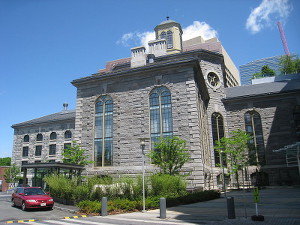
Photo by Daderot, 2009.
The American historical landscape is filled with sites where people who engaged in same-sex sex and transgressed gender binaries struggled to survive and thrive. In these locations, “sinners,” “deviants,” and “perverts” often viewed law as oppressive. Immigrants, poor people, and people of color who violated sex and gender norms had multiple reasons for seeing law as implicated in the construction and reconstruction of social hierarchies. Over time, however, people who identified or were classified as lesbian, gay, bisexual, transgender, or queer (LGBTQ) increasingly came to see law as a potential resource for protecting, defending, and improving their lives. In these contexts, law was a complicated and multifaceted resource, simultaneously freeing, limiting, and producing human sexes, genders, and sexualities. This chapter offers an introduction to historical landscapes and landmarks of US LGBTQ law, beginning with the European colonization of the Americas and concluding with developments in the 1970s and 1980s.[1] Read more » [PDF 2.7 MB]
[1] In this chapter I use gender and sexual terms that are generally favored today (including lesbian, gay, bisexual, and transgender) as well as historical terms (such as “deviant” and “pervert”) that are generally rejected today. I use analytic terms such as “same-sex sex” and “gender-crossing acts” to address behaviors rather than identities or communities. I use “queer” to reference same-sex and gender-crossing desires, behaviors, and identities. I refer to “LGBTQ acts, identities, and communities” when discussing the larger chronology of US history, though I do not mean to imply that LGBTQ identities existed in North America before the late nineteenth century or are relevant in all of the twentieth or twenty-first century contexts that are discussed.
The views and conclusions contained in the essays are those of the authors and should not be interpreted as representing the opinions or policies of the U.S. Government. Mention of trade names or commercial products does not constitute their endorsement by the U.S. Government.
Part of a series of articles titled LGBTQ America: A Theme Study of Lesbian, Gay, Bisexual, Transgender, and Queer History.
Previous: LGBTQ Civil Rights in America
Next: LGBTQ Military Service
Last updated: August 11, 2017
